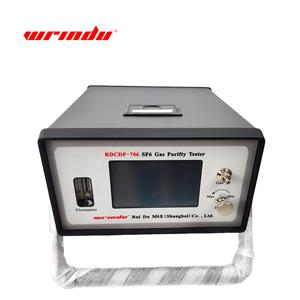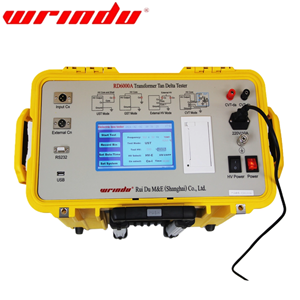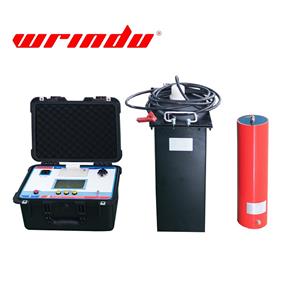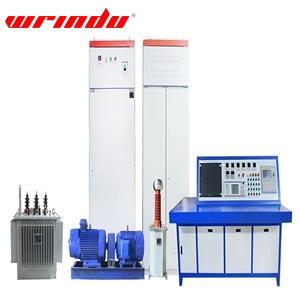What do you know about VLF testing, TD testing and PD testing?
Questions about Three Testing Methods
What is VLF testing, TD testing and PD testing?
How do you understand VLF testing, TD testing and PD testing?
What tests should be done when receiving cables?
What are the limitations of the three testing methods?
What are the advantages of VLF all-in-one machine?
What is VLF testing, TD testing and PD testing?
VLF testing means Very Low Frequency testing. It is a method used to assess the integrity of electrical insulation in high-voltage cables. A Very Low Frequency high voltage AC tester is used to perform a withstand test. A VLF instrument is relatively inexpensive, very easy to use, and quite portable, depending on model. And the main advantages of VLF testing are its affordability, portability and ease of operation. Compared with direct current (DC) testing, VLF testing is more suitable for testing high capacitive loads such as cables and motors/generators.
TD testing means Tan delta testing. It is a non-invasive diagnostic technique used to assess the condition of insulation in electrical equipment such as cables or transformers. It can also be called Dissipation Factor testing or Loss Angle testing. This test is applied to evaluate the dielectric losses within the insulation so as to get its capacity to store and release electrical energy. If tan delta value increases, it shows energy losses, which also indicates the insulation is deteriorating, often due to aging or moisture. After test, we can asses the remaining lifespan of the insulation and for making informed decisions regarding maintenance, replacement, or revitalization of the cable system by results.
PD testing meand Partial Discharge testing. It is a method used to is a non-destructive method used to assess the condition of insulation in high-voltage electrical equipment. PD is the failure of a part of the insulation system to withstand electrical stress and can detect the deterioration of the insulation system. PD testing can also reveal faulty accessories or use very low frequency (VLF) withstand voltage testing to detect defective accessories.
How do you understand VLF testing, TD testing and PD testing?
We can consider VLF (Very Low Frequency) testing is used for assessing the insulation integrity of cables, especially in high-voltage cable systems. Its main purpose is to evaluate the condition of the cable insulation and help identify potential faults or weaknesses. The typical application scenarios for VLF testing include post-installation insulation testing, post-repair inspections, preventive maintenance, and monitoring the health of aging cables. VLF testing is not only a routine testing method but also a critical step in ensuring the stability and safe operation of power systems.
However, VLF testing is not suitable for all situations. In many situations, it' s not ideal to induce failure in the cable during testing. So a more effective approach is to conduct diagnostic tests that assess the condition of the cable' s insulation and accessories without causing any failure. With the data from these tests, a decision can be made about whether to repair or replace the cable at a more convenient time. This can be done using either the Tan Delta testing, Partial Discharge testing, or a combination of both.
Besides, TD testing and PD testing usually require the use of VLF high voltage test equipment. Tan Delta testing is typically conducted using VLF high-voltage equipment. The voltage applied by the VLF device during the test helps reveal the behavior of the cable insulation at different voltage levels,thereby assessing the overall health of the insulation. In the meanwhile, during PD testing, the VLF high-voltage equipment applies low-frequency voltage (typically 0.1Hz), which helps simulate the electrical stress during normal operation and induces partial discharges. Using VLF as the voltage source effectively monitors partial discharges within the cable insulation, allowing for the identification of potential defect areas.
After you know the relationship between the three methods, you can better understand how to keep guarantee of cable health.
What tests should be done when receiving cables?
In the above information, you get the idea of VLF test can apply to post-installation insulation testing. Ruidu's technicians said that in general, when accepting cables in China, insulation tests must be performed after installation. In other countries, dielectric loss testing and partial discharge testing are sometimes required. But for our instruments, VLF test instruments generally do not have dielectric loss test and partial discharge test functions by default. If you need them, you can contact us for personalized customization.
What are the limitations of the three methods?
| VLF Testing | |
| Voltage and Cable Capacitance | VLF testers are rated based on both the voltage they can apply and the capacitance of the cable they can test. If the cable capacitance is too high, the VLF device may not be able to supply the necessary voltage for testing. |
| Neutral Condition | VLF testing requires an intact neutral or shield for accurate results. If the neutral is corroded or damaged, the test's effectiveness is compromised. |
| Failure Induction | Since VLF testing is a withstand test, it is designed to induce failures to locate weaknesses. This can be undesirable in cases where failure cannot be tolerated, such as in critical cables or when power outages are unacceptable. |
| Tan Delta Testing | |
| Cable Length | TD testing is most effective on shorter cables. Longer cables may result in inaccurate readings because the data becomes averaged out, and localized defects may not be observed clearly. |
| Capacitance Rating | Like VLF, TD testing also depends on the capacitance of the cable. Cables with high capacitance may require special equipment to ensure reliable measurements. |
| Neutral Condition | For accurate results, the cable’s neutral must be intact and properly grounded. Damage to the neutral can distort the measurements and make the test unreliable. |
| Test Conditions | TD testing is designed for general diagnostics and cannot pinpoint specific locations of faults or degradation. It’s better suited for assessing the overall health of the insulation, not for fault localization. |
| Partial Discharge Testing | |
| Cable Length and Signal Attenuation | PD testing is limited by the length of the cable. Longer cables may cause signal attenuation, making it difficult to detect partial discharges at the far end of the cable. The effectiveness decreases as the distance between the test equipment and the defect increases. |
| Background Noise | High levels of electrical noise from nearby equipment or cables can interfere with the PD measurement. Although modern PD equipment can filter out some of this noise, it remains a challenge in environments with significant electromagnetic interference. |
| Subjectivity of Results | Interpreting PD data can be subjective, as it often requires expertise to assess whether the level of discharge is acceptable. In some cases, accessories like splices and terminals may exhibit PD without leading to immediate failure, which complicates the decision-making process. |
| Neutral and Shielding Issues | Like VLF and TD, PD testing also requires a well-maintained neutral. The presence of defects in the neutral or shield can significantly reduce the accuracy of the test. |
In summary, VLF testing is effective for diagnosing overall cable integrity but can be less useful for specific fault location, especially if the neutral is compromised. And TD testing provides a general overview of insulation quality but struggles with longer cables and cannot pinpoint specific defects. PD testing is suitable for locating specific defects but can be hampered by cable length, background noise, and subjectivity in result interpretation. Each method can test useful information, and has its advantages and disadvantages. And in most cases, a combination of tests (such as PD and TD testing followed by VLF testing) provides a comprehensive understanding of cable health.
What are the advantages of VLF all in one machine?
The integrated ultra-low frequency high-voltage generator is independently developed using cutting-edge American technology, equipped with a 7-inch touch screen, ARM7 single-chip microcomputer and high-speed AD acquisition circuit, and supporting background management software. This product breaks through the defects of similar domestic equipment, and its cost performance is better than imported products. It is especially suitable for withstand voltage testing of electrical equipment with large insulation equivalent capacitance such as power cables, capacitors, large and medium-sized generators/motors.
Advantage One: The product is controlled by a microcomputer, and the test process of boosting, bucking, measurement, protection, etc. is fully automated, with automatic storage and automatic printing.
Advantage Two: The controller and the high-voltage generator are connected at low voltage, photoelectrically controlled, and safe and reliable to use.
Advantage Three: It adopts a high and low voltage closed-loop negative feedback control circuit, and the output has no capacitance rise effect.
Advantage Four: Multiple frequency selections such as 0.1Hz, 0.05Hz and 0.02Hz, with a large test range.
Click here to find more information about VLF testing equipment、VLF all-in-one machine、Tan Delta Testing Equipment、Partial Discharge Tester.




